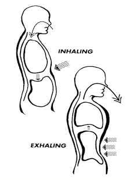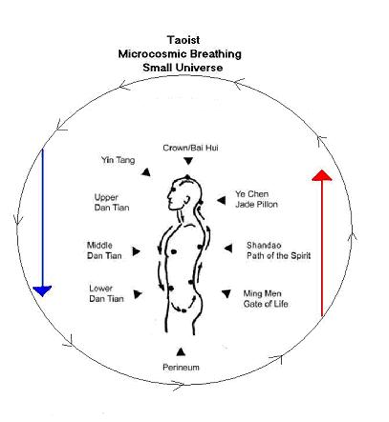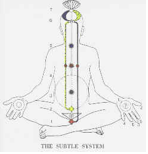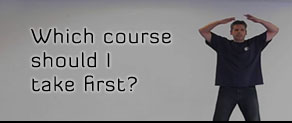Clinical studies prove that oxygen, wellness, and life span are totally dependent on proper breathing. Lung volume is a primary marker for how long you will live. Consider this:
A) Science has proven that cancer is anaerobic – it does not survive in high levels of oxygen.
B) Shortness of breath and heart disease are directly linked – the heart goes into spasm when it is deprived of oxygen.
C) Studies have shown that there is a high correlation between high blood pressure and poor breathing.
D) Most emotional issues, including anxiety and depression, result from the nervous system being out of balance. Breathing drives the central nervous system and vice versa. The Oriental philosophy teaches that each mental and physical state of the individual is represented by a special rhythm of breath, the rhythm and condition always being found together. The mental or physical condition will invariably manifest the particular rhythm of breath, which belongs to it; and, likewise (and this is one of the occult secrets) the deliberate assumption of a particular rhythm of breath will speedily result in the manifestation of the appropriate physical or mental condition. You will find that a few moments of “anger-breath or fear-breath” (if well acted out, or assumed faithfully) will result in you soon experiencing a feeling of anger or fear, as the case may be. Likewise, you will find that the deliberate assumption, on your part, of the breath-rhythm of peace, calm, self-control, will be sufficient to induce that particular state of feeling within you.
E) Optimal Breathing helps to promote weight loss. Oxygen burns fat and calories.
F) Breathing well is the key to sleeping well and waking up feeling rested. Breathing provides 99% of your energy. Without energy, nothing works.
G) Virtually every health condition and human activity is improved with Optimal Breathing.
Breathing supplies over 99% of your entire oxygen and energy supply. Poor breathing causes or worsens chronic maladies such as asthma, allergies, anxiety, fatigue, depression, headaches, heart conditions, high blood pressure, sleep loss, obesity, harmful stress, poor mental clarity plus hundreds of other lesser known but equally harmful conditions. ALL diseases are caused or worsened by poor breathing.
The average person reaches peak respiratory function and lung capacity in their mid 20’s. Then they begin to lose respiratory capacity: between 10% and 27% for every decade of life! So, unless you are doing something to maintain or improve your breathing capacity, it will decline, and with it, your general health, your life expectancy, and for that matter, your spirit as well.
Optimal breathing gets you more vitality and better quality of life. We also address food, exercise, internal cleansing, attitude, and environment but breathing is for many the most important part of getting and staying healthy. Begin with breathing. Better breathing is possible for anyone. Develop your breathing now.
This article focuses on correct diaphragm deep breathing exercises for health, vitality and spiritual meditation work, which includes Nei Kung and Shen Kung exercises for awakening Kundalini (Greater Kan & Li) and enlightenment.

 Deep Diaphragm breathing (also known as Buddha Breathing or Baby’s breath) should cause the lower abdomen (area below the navel) to expand on inhalation and to contract on exhalation. The lower abdomen expands as a result of the downward force of the diaphragm’s contraction as it moves down.
Deep Diaphragm breathing (also known as Buddha Breathing or Baby’s breath) should cause the lower abdomen (area below the navel) to expand on inhalation and to contract on exhalation. The lower abdomen expands as a result of the downward force of the diaphragm’s contraction as it moves down.
To further correct breathing, one should exhale at a slow comfortable pace until one begins to feel that no more air can be expelled. Once this point is reached, you should pull your stomach muscles inwards (suck in the gut) towards the spine to squeeze out the remaining air. This will allow the stomach to expand quite naturally on the next “slow, comfortable” inhalation.
Explanation of breathing patterns:
1) Linear Breathing- There is no retention or breath and the inhalation and exhalation are both even. For example, lets say that we assign a numeric rhythm of “4” to the breathing pattern. This means that we would inhale for a count of 4-seconds and then immediately and seamlessly exhale for another count of 4-seconds. This is linear breathing.
2) Triangular Breathing- Using our same numeric value, and proper diaphragmic technique, you would inhale for a count of 4-seconds, retain or hold your breath for 4-seconds and then exhale for a count of 4-seconds, upon which you would immediately inhale again repeating the pattern.
3) Square Breathing- Using the numeric value of 4 as in the prior examples, you would inhale for a count of 4, hold your breath for a count of 4, exhale for a count of 4 and then prevent inhalation for another count of 4 prior to repeating the pattern. Thus square breathing has a “pause or gap” for both breath retention and prevention prior to inhalation and exhalation.
4) Double Breathing- Using the same value, one would inhale for a count of 4, pause for a moment to allow the diaphragm to reset without exhaling, then inhale again for another count of 4 to intake additional air and energy if one is aware of chi (Qi, Prana, Ki, Life Force). The exhaling breath would be similar, expelling the air for a count of 4, pausing a moment and then exhaling again for another count of 4. This concept can be expanded to Triple Breathing, Quadruple Breathing, etc.. Yogic runners typically inhale through their nose in small sniffs in multiples of 9 with advanced practitioners reaching 108 inhaling sniffs. They exhale through pursed lips in the same count used on the inhalation. The only time they hold their breath is for jumping or hurdling over an object or to leap a great distance.
5) YIN Breathing- The inhalation process is at least 2x longer than the exhalation process. Breath retention & prevention can be added to the process. Typically, breath prevention until one feels “mildly desperate” for air is the most common technique.
6) Yang Breathing- The exhalation process is at least 2x longer than the inhalation process. Just like YIN breathing, breath prevention or retention can be added. Typically, holding the breath until one feels “mildly desperate” to exhale is the most common method.
7) Taoist Breathing- Also known as reverse breathing and/or embryonic breathing is another deep diaphragmic method, but reverses the expansion and contraction of the stomach. During the inhalation process, one pulls the lower stomach inwards towards the spine to create a squeezing or upward draw effect. As you exhale, you relax the stomach allowing it to expand and at the very end of the exhale you push it out “slightly” to create an internal pressure in the lower stomach. This method should not be used until one can either feel heat in the 2nd chakra area (Dan Tien) or they have a sensation of “air, current, or energy flow” coming down their spine during inhalation and moving up the front of their body and out the nose or mouth during exhalation. Once these sensations are perceived, then Taoist Breathing is used to reverse this process, bringing the energy or heat up the spine during the inhalation and following the flow down the front of the body into the 2nd chakra during exhalation, creating a pressure like feeling in this location. Taoist Breathing can be linear, triangular, square or double as well as YIN or YANG.

An alternate nostril breathing exercise – purifying breath: Can be linear, triangle or square breathing. Triangle is the most common utilized. This exercise improves brain function balancing both hemispheres, sooths the central nervous system, improves sleep, balances energy flow and has an overall revitalizing effect.
Step one: Use right thumb to close off right nostril.
Step two: Inhale slowly through left nostril
Step three: Pause & hold the breath in for a second
Step four: Now close left nostril with ring finger and release thumb off right nostril
Step five: Exhale through your right nostril
Step six: Now, inhale through right nostril
Step seven: Pause
Step eight: Use thumb to close of right nostril
Step nine: Breathe out through left nostril
Step ten: This is one round. Start slowly with 1 or 2 rounds and gradually increase the amount of practice. Never force it to an uncomfortable level. Sit quietly for a few moments after you have finished and relax as your normal breath rhythm returns.
With practice, you may begin to perceive energy flowing up and down the side channels of the body known as ida (left side) and pingala (right side).
This concludes the basic secrets of breathing practice. There are many other techniques, but the ones listed here are the easiest to learn and form a solid foundation for other breathing practices. The practices outlined herein are also best suited for meditation, kundalini activation and Qigong training, which is another reason they were highlighted in this short manual.


I hear that emphesima is not curable,
on the the other side I read your articles,and getting a lot of hope from it.
I really like your article its thorough VERY informative and I like to get MORE info from you on a steady base.
can you recommend a hands on breathing specialist i can contact in Toronto Canada.
Thanks so much!
Nick Rabin